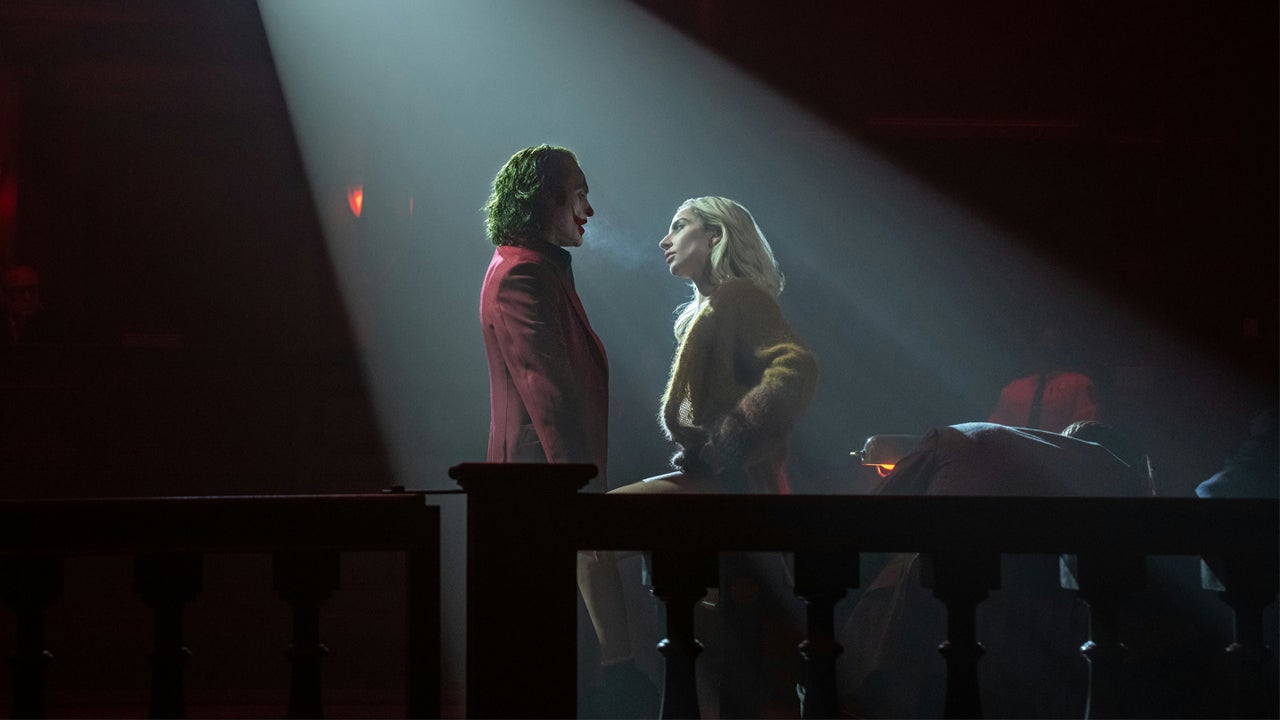Joker: Folie à Deux opens in theaters Friday, October 4. This review is based on a screening at the 81st Venice International Film Festival.
Joker: Folie à Deux charges out of the gate with a novel approach to DC’s most famous villain, but it soon settles into rote rhythms. Though advertised as a dreamy jukebox musical, the sequel to 2019’s Joker is actually more of a courtroom drama, and not a very interesting one at that. The film works best when pushing towards new ways of seeing its central character – often through the eyes of a wonderfully realized Harley Quinn, played by Lady Gaga – but it too often insists on returning to familiar territory (and on occasion, familiar footage) instead of blazing a new path.
Arkham Asylum is now home to Joker/Arthur Fleck (Joaquin Phoenix), whose daily routine involves being awoken by gruff prison guards who demand jokes from him while he empties his latrine. It seems like Arthur no longer speaks very much – he certainly no longer smiles – and director Todd Phillips, with the help of cinematographer Lawrence Sher, captures this mechanical morning process in long, unbroken takes that draw the viewer into Joker’s grimy world. As he awaits trial, his lawyer Maryanne Stewart (Catherine Keener) insists he pleads insanity, and figures that the best defense is to treat “Joker” and “Arthur” as distinct personalities living in the same body.
Arthur, like most people around him, knows this more of a legal strategy than anything resembling truth, but the question of how his adopted persona changes him constantly looms. On one hand, separating Joker’s actions from Arthur’s (and framing them as a trauma response) might get him an easier hearing. On the other hand, when he draws the gaze of fellow patient and avowed admirer Harleen “Lee” Quinzel, it seems like Joker is who he wants, and needs, to be.
Since the two meet during musical therapy, real and imagined songs are scattered throughout Folie à Deux’s runtime. Most of these are familiar Hollywood tunes (some are mixed with Hildur Guðnadóttir’s eerie, booming score), though the movie features a couple of originals too. Sadly, none of these are particularly catchy, and one of them – in which Phoenix and Gaga sing about mountains – is downright embarrassing, but at least it’s sincere. The duo, at first, connects through song. They match each other’s freak – the shared madness and delusion of the subtitle, what the French call “folie à deux” – but much of this ends up sidelined during the movie’s lengthy courtroom scenes, which promise chaos when Arthur begins representing himself. Unfortunately, the delirium of Phoenix smearing on the grease paint to play both attorney and defendant isn’t quite delivered.
After an initial hour set entirely within Arkham’s walls, the sequel becomes a kind of referendum on the first Joker, though not in any meaningful, transformative way. Rather, it’s merely an extension of the first film’s plot in the most plodding and literal fashion. For a film that’s almost entirely liberated from its comic book source material, Joker: Folie à Deux is oddly constrained by its own predecessor. Returning characters show up to narrate events we’ve already seen, as Stewart asks leading questions about Joker feeling like a distinct entity from Arthur. On the flip side, the prosecutor is a smarmy Harvey Dent (Harry Lawtey) – the comics’ villainous Two-Face – who’s a treat to watch at all times, though his line of argument sheds little light on Arthur’s actions or state of mind.
Perhaps the standout of this extended segment is Gary (Leigh Gill), Arthur’s clown colleague from the first movie, whose dwarfism comes ever-so-close to being the subject of Arthur’s comedic riffing when he takes the stand. If the sequel comes close to articulating an actual point about Joker – that is to say, the persona and identity – it’s that the coping mechanism that shields Arthur from the world’s cruelty makes him cruel in turn. However, like many potent ideas upon which Folie à Deux touches, it’s soon discarded. Similarly, Arthur’s upbringing and abusive mother, detailed in Joker, are rehashed ad nauseam, while the topic of Arthur’s future with Lee (which could potentially involve a family) is quickly abandoned before it can offer any kind of thematic reflection.
Folie à Deux too often insists on returning to familiar territory instead of blazing a new path.
This is the sequel’s default M.O., making it a frustrating experience beyond its initial, Arkham-focused hour. At first, it creates a more careful and methodical aesthetic than Joker – each scene is carefully composed; each methodical push-in has clear emotional intent – but as it progresses, it does little with its camera worth commenting upon. A few dreamlike flourishes do appear, though mostly to quote the familiar visuals of other musicals, like Jaques Demy’s French New Wave landmark The Umbrellas of Cherbourg and Francis Ford Coppola’s sincere, expressionistic One from the Heart.
Apart from these stray references, Phillips’ expressionism is limited to making each environment and lighting source resemble, in some way, a harsh spotlight on a stage, silhouetting Joker and Lee until they become defined by their shape – their iconography. It’s a great idea in theory, and taps into the performance aspect associated with the Joker character, but it rarely evolves, visually or conceptually. It’s just one of several things that ends up keeping the character in stasis, to the point that a vital emotional turn in the second half, which defines the movie’s trajectory, comes entirely out of left field. It’s one movie, and then suddenly, it’s another.
That said, Phoenix clearly knows this character inside out by now. His posture is even more disconcerting this time; the actor is still shockingly gaunt, but the way he carries himself speaks to a body that has endured a life of abuse (something as simple as uneven shoulders can go a long way). When Arthur decides to embrace the “Joker” part of himself, this posture changes, almost fixing itself, as Phoenix sprawls out across the screen, luxuriantly, comfortably, and confidently – usually with a cigarette in hand. However, he never loses Arthur’s inherent goofiness even when putting on this front. As the Joker slips between forms of presentation, his accent slips as well, going from British to American Southern and back, as if he can’t quite figure out who (or what) he wants to be.
How Todd Phillips got Joaquin Phoenix to do a Joker sequel
“He didn’t want to let Arthur go. He goes, ‘We should do this on Broadway or something.’ He had this vision, and again, 50 to 80% of it was us just fucking around joking. And that’s sort of the creative process. And then I’ll call Scott and go, ‘What do you think about that?’ And we just bounce around ideas. That’s just sort of how everybody works. But I didn’t think it was as big a departure as I believe the internet felt when they heard there’s music involved. Because to me, the music was a really driving factor in the first film. … The first thing I ever said to Joaquin when we started talking about Arthur was that, ‘Yes, he’s left-footed. Yes, he’s out of step with the world, but there’s a music in him.'”
Read the complete interview with the Joker: Folie à Deux filmmakers answering the first movie’s biggest questions
But if Joker: Folie à Deux has a not-so-secret weapon, it’s Lady Gaga’s rendition of Harley Quinn, whose fascination with Arthur is the film’s very foundation. It’s a shame the movie never quite allows its musical elements to bloom (the energy of these segments only goes so far), because affording Gaga the chance to run the emotional and tonal gamut would have likely resulted in one of the greatest feats of screen acting modern Hollywood has seen. She even modulates her singing voice between the real Lee (an unprofessional who belts with an uneven passion) and Arthur’s imagined version of her, whose singing is more, well, Gaga-esque. Sadly, she’s constrained by a subtle performance in a film that’s anything but.
The careful line Gaga walks between adoration and mania is entirely worthwhile, and temporarily allows a commentary on fandom obsession to sneak its way into the picture. (Lee is practically a Manson girl.) However, in true Phillips fashion, this idea never really comes to fruition. Before it has the chance, Joker: Folie à Deux switches tangents yet again. That’s to say nothing of the movie’s intriguing oedipal undercurrent, which frames Arthur’s desire for adoration as a response to a lack of maternal warmth; no prizes for guessing how far this gets.
Joker, though scattered in its politics and committed to aping other, better filmmakers, at least had unifying visual and thematic motifs. It felt complete, albeit cobbled together. Joker: Folie à Deux departs from this approach – initially for better, though eventually for worse. Its more considered frames and character dynamics set the stage for musical romance that never blossoms – visually, acoustically, emotionally – giving way to a sequel weighed down entirely by its predecessor, despite how hard it tries to escape its orbit.












